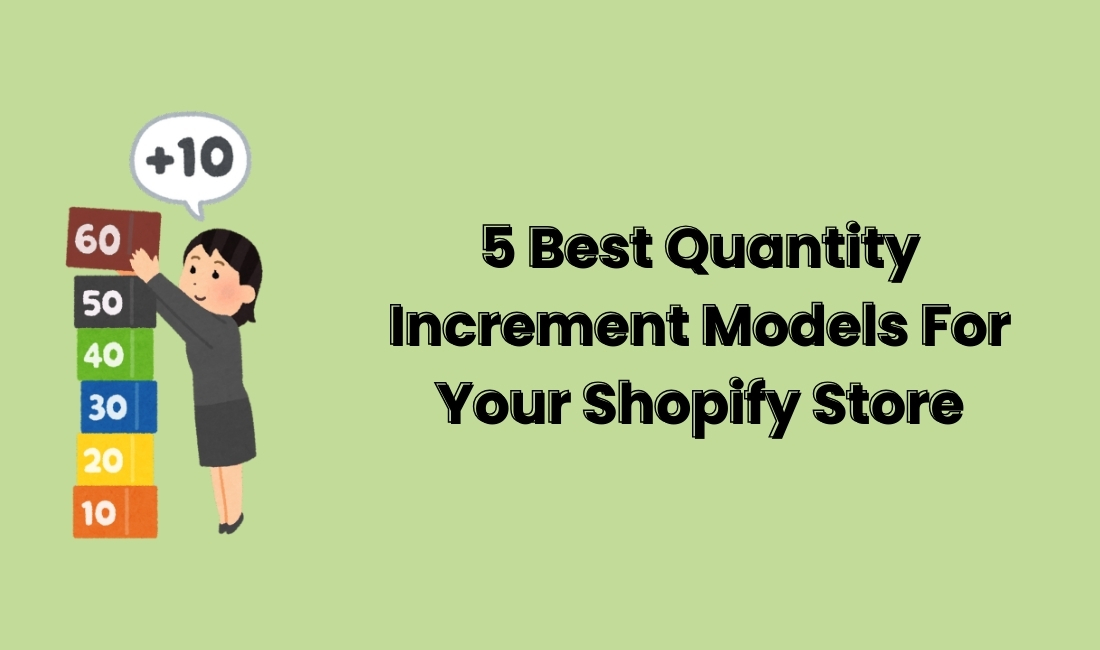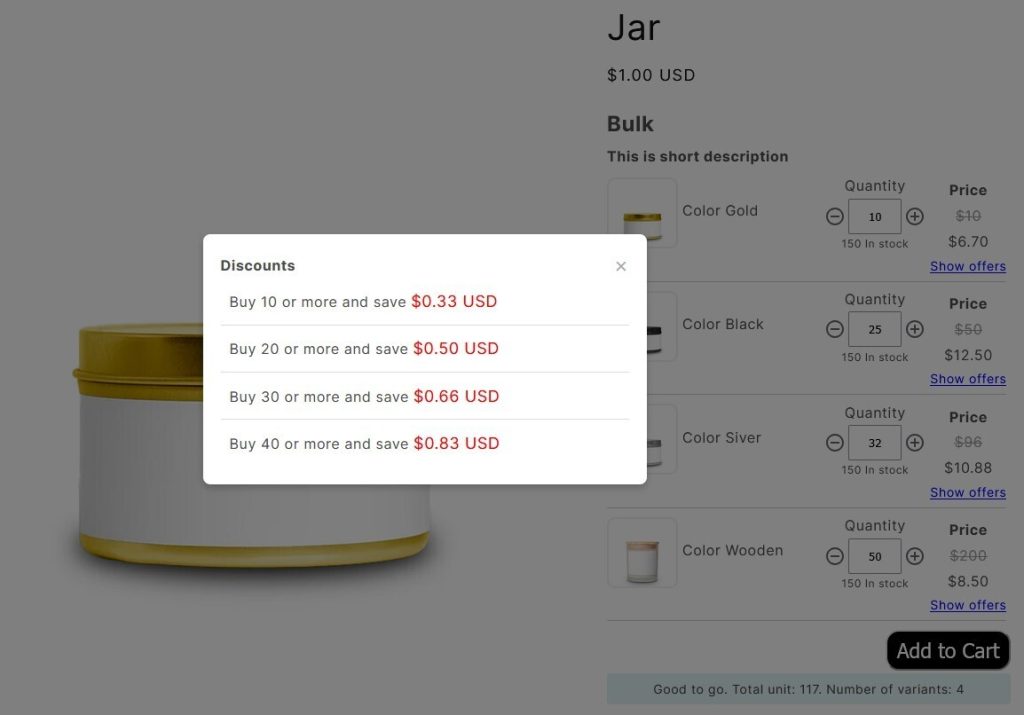
Imagine you sell wholesale coffee beans.
One month, a café picks up 17 bags; the next month, it’s 22. You’re left second-guessing – roast more, or hold back? Sometimes you’ve more beans than you need. Other times, you’re out before the next delivery.
Now, let’s change one small thing – sell beans in packs of 10. That same café starts buying 20 or 30 bags at a time. Now you have a clear idea of how much stock you might need.
That’s what a quantity increment model does. It turns scattered, unpredictable orders into clear patterns you can work with.
It’s a win for B2B sellers and wholesalers. You can enjoy smoother operations and bigger orders without the back-and-forth. Even retail shops can use these models!
Here’s what it does for you:
- Increases AOV
- Keeps inventory management easier
- Rewards loyal buyers with simple, fair deals
Next, we’ll break down the main types of quantity increment models. What they are, how they work, and when they can give your store the biggest lift.
- Variant-Level Fixed Increments – Sell products in fixed packs (e.g., 3 per pack). Helps with inventory planning, simplifies shipping, and reduces fulfillment errors.
- Incremental Quantity Discounts – Offer discounts when customers buy more (e.g., 10% off 10+ units). Encourages larger orders and attracts bulk buyers.
- Tiered Discount UX – Show multiple discount tiers upfront. Motivates customers to buy more and makes savings transparent.
- Cart-Level Minimums – Require a minimum number of items per order. Drives bulk purchases and streamlines operations.
- Automated Replenishment – Suggest reorder quantities based on past purchases. Keeps inventory optimal and improves customer experience.
Table of Contents
Benefits of Using Quantity Increment Models
Quantity increment models aren’t simple rules. They shape buying behavior, simplify your operations, and protect your margins. They make your store run smoother and earn more without extra effort.
Higher Average Order Value (AOV)
With set increments, like packs of 5, buyers meet the minimum pack size instead of adding one item at a time. The total order is higher without you having to push upsells manually. Over multiple orders, it steadily raises your average revenue per customer.
Easier Inventory Management
Random order sizes make stock unpredictable. With increments, each product moves in predictable chunks. You can plan shipments, restock at the right time, and avoid tying up cash in excess inventory. It also reduces errors, since you’re tracking fewer unique quantities.
Better Margins
Bulk pricing rewards larger purchases without slashing profits. Instead of discounting every unit, you only give buyers a break once they hit the next increment. You sell more units, move inventory faster, and keep your per-unit margins healthier.
Smooth Operations
Packing and shipping have become faster. There will be less scope for any mistakes. Orders coming in standard sizes mean fewer adjustments and less confusion for your fulfillment team. This lowers labor time and shipping mistakes.
Less Customer Confusion
Clear rules up front prevent misorders. Customers immediately see how much they need to buy, reducing abandoned carts and support questions. They feel confident completing their order, and you spend less time clarifying quantities.
Edge Over Competitors
Shoppers stick with stores that are easy to buy from. Increment rules simplify ordering, so customers don’t have to calculate bulk discounts themselves. A smoother process encourages repeat orders and loyalty.
Model#1 Variant-Level Fixed Increments
Variant-level fixed quantity increment model is a straightforward way to control how customers buy your products. Simply put, you set rules so certain variants must be purchased in fixed multiples. For example, if you sell a T-shirt in Size XL, you might require buyers to order it in packs of three instead of one or two.
This approach works especially well for B2B wholesale orders or products that are costly or tricky to ship in single units. Imagine shipping a bulky item. You’d rather send them out in predictable bundles to save on packaging and shipping costs.
Here’s why fixed increments can help your store:
- Predictable inventory turnover: You know exactly how many units move per order, making stock planning easier.
- Reduced shipping complexity: Packing multiples means fewer individual packages and less chance for errors.
The key is to make the rules clear on your product pages; customers shouldn’t be surprised at checkout. A simple note like “Sold in packs of 3” right by the variant choice avoids frustration and cart abandonment.
Think of it like a friendly nudge that helps your customers buy the right quantity while keeping your operations smooth. It’s a small tweak that can save time and boost your wholesale sales without extra hassle.
Model#2 Incremental Quantity Discounts
Incremental quantity discounts are a smart way to reward customers who buy more without cutting your margins on smaller orders. Here’s how it works: you set pricing so the first few units sell at a regular price, and any units beyond a certain number get a discounted rate. For example, units 1 through 5 might be $10 each, but starting at unit 6, the price drops to $8 each.
This strategy is perfect if you want to encourage bigger purchases but still keep profits steady on small buys. It gives your customers a clear reason to add more to their cart, without feeling like everyone’s getting a steep discount.
Here’s why incremental discounts work:
- Flexible pricing that rewards volume buyers without undermining your base price
- Helps you keep profits steady while growing order size
- Makes your store feel fair and transparent
To make this happen on Shopify, bulk order apps like MultiVariants can set up these rules.
Pro tip: Show customers their per-unit savings as they add more products. When shoppers see how much they save with each extra item, it nudges them to buy bigger quantities.
In the end, incremental discounts are an easy win: you boost sales, keep margins intact, and make customers happy, all with just a little pricing magic.
Model#3 Tiered Discount UX
Tiered discount UX means showing your customers multiple discounts upfront, so they see the rewards of buying more right away. For example, you might display “Buy 6, Save 10%” or “Buy 12, Save 15%” clearly on your product page. This helps customers quickly understand the perks of ordering bigger quantities.
This strategy works best for retail customers who might not realize you offer bulk pricing. It nudges shoppers to add more by making the discounts visible before they even add items to the cart. Instead of surprises at checkout, customers see the benefits early, which builds trust.
Here’s what makes tiered discounts a winner:
- Improves transparency on pricing and savings
- Encourages customers to buy in higher quantities without pressure
- Makes your store feel fair and straightforward
The integration of MultiVariants and DiscountRay, a discount app, can set up these rules without hassle.

Pro tip: Use visual aids like progress bars or badges to make the savings pop. A progress bar that fills as customers add items or badges that highlight savings can boost conversions by making discounts feel real and achievable.
Model#4 Cart-Level Minimums
Cart-level minimums are rules that set a minimum total amount customers must reach before checking out. For example, you might require the entire cart to total at least $100. This is a simple way to encourage larger orders and cover costs like shipping or handling.
This approach is perfect for wholesale stores, low-margin products, or businesses that need to offset shipping costs. It’s easy for customers to understand and quick for you to set up.
Here’s why cart minimums work well:
- Clear and simple rules reduce confusion
- Encourages customers to add more to reach the minimum
- Helps protect your margins and shipping costs
Pro tip: Combine your cart minimum with free shipping thresholds. For example, offer free shipping on orders over $150, which encourages customers to go beyond the minimum and spend even more. This pairing creates a win-win: you get bigger orders, and customers feel like they’re getting a deal.
Model#5 Automated Replenishment
Automated replenishment means setting up your store or system to remind customers to reorder or even reorder automatically once stock hits a certain level. For instance, when inventory drops below 10 units, an automatic reorder can trigger, or customers can get a friendly reminder to restock.
This is especially useful for subscription products or consumables that customers buy repeatedly. It keeps them coming back without them having to think about it. It also helps you avoid out-of-stock headaches.
Here’s why automated replenishment is a smart move:
- Prevents stockouts that can hurt sales and customer trust
- Builds long-term loyalty by making reordering effortless
- Saves time for both you and your customers
Pro tip: Pair automated reorder triggers with email or SMS reminders. Sending a quick nudge before stock runs out encourages customers to reorder on time, reducing lost sales and improving their experience. It’s like a helpful friend reminding them to restock, which keeps your products top of mind.
Conclusion
Quantity increment strategies aren’t just about rules. They’re smart tools to grow your business. Whether it’s fixed multiples for predictable stock, incremental discounts to reward big buyers, tiered pricing to nudge shoppers, cart minimums to boost order size, or automated replenishment for repeat sales, each model serves a purpose.
Try mixing these tactics to see what clicks with your customers. Remember, quantity strategies aren’t just operational. They’re real revenue drivers.
FAQ: Quantity Increment Models
How can I set minimum, maximum, and increment limits for product quantities in my Shopify store?
You can implement these rules using the Shopify app MultiVariants. These apps allow you to define specific quantity requirements per product or variant, such as setting a minimum purchase quantity, a maximum limit, or enforcing fixed increments (e.g., multiples of 5). For more advanced customization, Shopify Plus merchants can use Shopify Scripts or custom Liquid code with metafields to enforce these rules.
Do I need a Shopify app to offer quantity discounts, or can I do it natively?
While Shopify provides basic discount features, using a dedicated app can offer more flexibility and customization. Apps like DiscountRay allow you to set tiered pricing, volume discounts, and bundle deals with ease. These apps often provide real-time savings displays, progress bars, and support for customer-specific pricing.
How can I display quantity discount information on product pages?
To showcase quantity discounts on product pages, you can use apps like DiscountRay. It works perfectly with MultiVariants. These apps enable you to display tiered pricing, volume discounts, and bulk offers directly on the product page.
Why is it important to use a quantity increment model for Shopify stores?
A quantity increment model increases the average order value. You will be able to manage your inventory easily. You can achieve better margins, smooth operations, and an edge over competitors.
How do I prevent overselling when customers purchase in fixed increments?
To avoid overselling, ensure that your inventory management system is synchronized with your quantity rules. Use third-party apps to manage stock levels and automate reorder points. Additionally, communicate your quantity rules on product pages and during checkout to set proper expectations with customers.
